For the Love of Birds: Seven Birds from North Carolina’s list of Species of Greatest Conservation Need
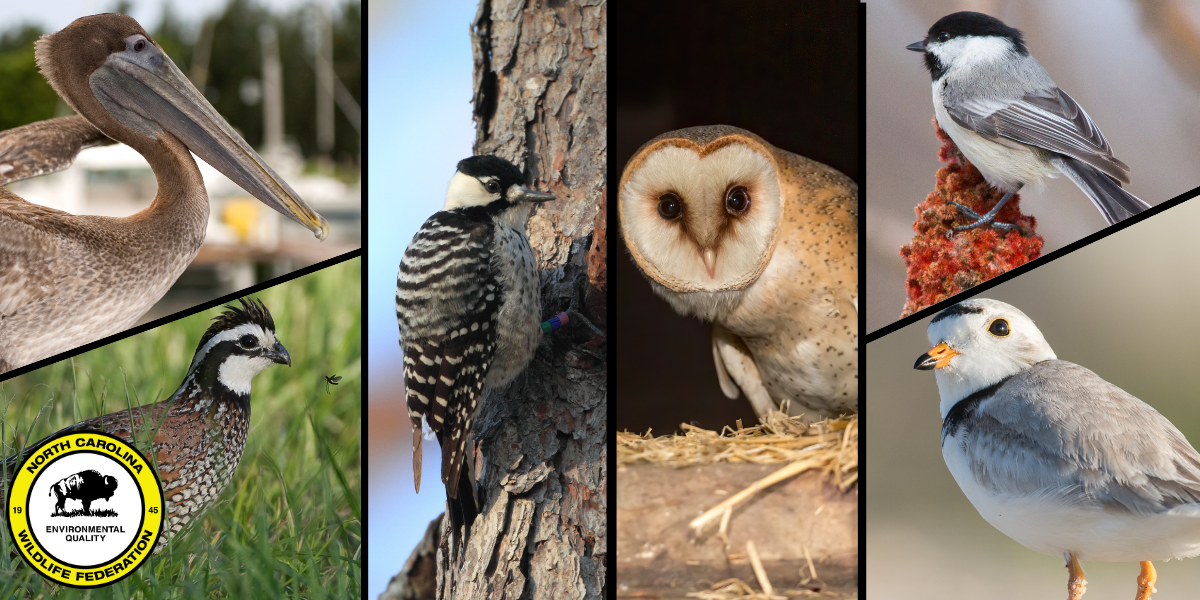
“Birds are indicators of the environment. If they are in trouble, we know we’ll soon be in trouble.” – Roger Tory Peterson, renowned American naturalist and ornithologist
Ecosystems are complex and dynamic, and require the presence and contribution of all of its members. Whenever one element of those ecosystems is damaged or absent, the entire ecosystem suffers – like removing a single gear from a piece of machinery.
At the same time – nature and its ecosystems are resilient. For millions of years, they have evolved and adapted to natural disasters, changing climates, and extinction events. Keystone species have been wiped out and replaced by others.
Yet, in the face of rapid urbanization, unchecked development, burgeoning human populations, and escalating pollution, the toll on habitats and the wildlife within them – through loss, degradation, and fragmentation – is unprecedented. The pace of impact surpasses the natural adjustments ecosystems have historically made. The consequence is an expanding list of threatened and endangered species, prompting conservation organizations and federal and state agencies to double down on their conservation and protection efforts.
In January, 2024, North Carolina Wildlife Federation spotlighted “For the Love of Birds,” directing attention to the vital avian members of our North Carolina ecosystems. The state’s Wildlife Action Plan, developed by the North Carolina Wildlife Resources Commission (NCWRC) and partners, identifies 93 bird species in the state as Species of Greatest Conservation Need (SGCN). These birds, found from the mountains to the coast, play pivotal roles in maintaining the ecological balance of their respective habitats.
Beyond their ecological significance, it’s crucial to acknowledge the potential cultural and natural heritage losses associated with the decline and disappearance of these species. Protecting these species means protecting a natural identity, and working against the possibility of these species’ absence.
In this blog, we embark on a journey to explore a selection of SGCN-listed bird species found in North Carolina. Through understanding and appreciation, we hope to foster a collective commitment to preserving these feathered ambassadors of our state’s diverse ecosystems.
Red-Cockaded Woodpeckers (Leuconotopicus borealis):
NC Range: Eastern/Coastal
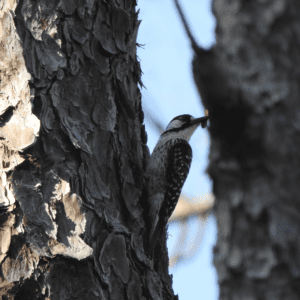 The red-cockaded woodpecker (RCW) is a small woodpecker, with a length of just seven inches. A cavity-nesting species, they are the only woodpecker in North Carolina to excavate cavities in living pine trees, likely due to the resistance of live pine trees to wild and prescribed fires.
The red-cockaded woodpecker (RCW) is a small woodpecker, with a length of just seven inches. A cavity-nesting species, they are the only woodpecker in North Carolina to excavate cavities in living pine trees, likely due to the resistance of live pine trees to wild and prescribed fires.
While RCWs take up residence in many species of pine trees, they prefer longleaf pine cavities and feed on insects found on or beneath the bark of the tree. Their abandoned cavities are often used by other wildlife species such as lizards, rodents, and other birds, making RCWs a keystone species to forest structures. According to the NCWRC, at least 27 species of vertebrates have been documented using RCW cavities.
RCWs typically live in family groups consisting of a breeding pair and up to four offspring who stick around with their parents for years after fledging. These mature offspring are known as “helpers” and participate in a “cooperative breeding system” where they essentially act as babysitters for the nest, incubating and caring for newborn nestling woodpeckers.
Once a common species throughout long-leaf pine ecosystems, the red-cockaded woodpecker is endangered due to the decimation of critical habitat following increased farming practices in the state, urbanization, and the failure to utilize prescribed burning as a means to provide essential long-leaf pine habitat for the species. As a result, according to NCWRC, the reduction of suitable habitat has caused the number of red-cockaded woodpeckers to decline by approximately 99% since the time of European settlement. Once considered a common species, the red-cockaded woodpecker now tragically boasts a mere 14,000 estimated remaining birds across eleven states.
The RCW was listed as endangered in 1970 and received Endangered Species Act (ESA) protection upon passage of the act in 1973. According to the US Fish and Wildlife Service (USFWS), the reinstitution of several self-sustained breeding populations of RCWs would meet recovery standards, a goal that has yet to be achieved.
As a fire-adapted species, RCWs depend on regular controlled burning of the pine ecosystems they call home. Before human involvement on the landscape, lightning was responsible for the burning that took place on the land that RCWs occupied. Now, controlled burning is used as a management tool to mimic the low-intensity fires once only started by environmental forces.
Though much of the RCW species protection and habitat management that occurs takes place on state and federal land, private landowners have the opportunity, through NCWRC’s Red-cockaded Woodpecker Safe Harbor Program to implement land management techniques that benefit RCWs, in exchange for regulatory assurances that no additional ESA restrictions will be imposed as a result of landowner management actions.
This Valentine’s Day, show your love for red-cockaded woodpeckers and the longleaf pine habitat they need for survival by making a donation to NCWF. Your donation will go towards planting longleaf pines in North Carolina, advocating for continued protections of red-cockaded woodpeckers under the Endangered Species Act, and educating people about red-cockaded woodpeckers and their longleaf pine habitat.
Brown Pelicans (Pelecanus occidentalis):
NC Range: Coastal
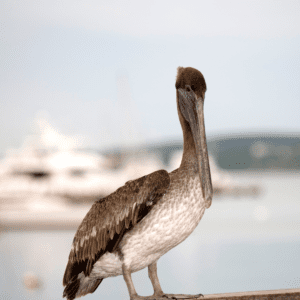 The brown pelican, though one of the smaller pelican species, still ranks among the larger coastal North Carolina seabirds with a length ranging between three to five feet and a wingspan exceeding six and a half feet.
The brown pelican, though one of the smaller pelican species, still ranks among the larger coastal North Carolina seabirds with a length ranging between three to five feet and a wingspan exceeding six and a half feet.
These social birds prefer the company of their kind for both breeding and feeding, forming colonies of thousands in island and coastal regions. While generally migratory and drawn towards warm coastal areas for nesting, some birds become year-round residents, risking frostbite on their webbed feet and throat pouches during colder months. When engaging in dispersing behavior, brown pelicans move away from their birth congregation to join a separate breeding congregation, enhancing genetic diversity.
Strictly marine, brown pelicans stick to coastal waterways, avoiding venturing too far out to sea, typically staying within 20 miles of the coast. Their colonies shift frequently, yet they nest in safe locations like secluded islands, sand dunes’ vegetation, or on cliffs. Breeding occurs once a year, usually around April, resulting in a brood of two to four eggs.
Piscivorous by nature, brown pelicans feed almost exclusively on fish, including anchovies crucial for regurgitation during nesting. Unlike other pelicans, they dive from the air for fish, distinguishing them from their sister species, the Peruvian pelican. While adult predation is rare, eggs and hatchlings face threats from gulls, raptors, alligators, feral dogs and cats, raccoons, and fire ants. Parasite infestations afflict adult pelicans due to their fish-based diet.
The brown pelican population saw a decline in the 1940s due to the widespread use of dichloro-diphenyl-trichloroethane (DDT; a synthetic insecticide), thinning eggshells and rendering young inviable. Listed under the ESA from 1970 to 2009, a ban on DDT and reintroduction efforts led to population growth, removing brown pelicans from the endangered species list. Despite this progress, coastal pollution, including oil spills and fishing litter, poses a threat. NCWRC protects nesting sites to prevent tampering and destruction by both humans and predators.
Barn Owls (Tyto alba):
NC Range: All Regions
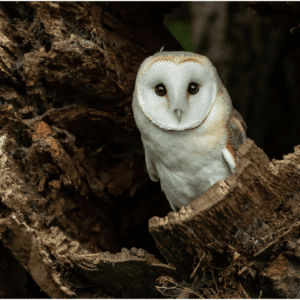 Barn owls are among the smaller owl species in North Carolina and display a distinctive appearance with a white face and belly complemented by golden brown anterior feathers. Unlike the familiar hoot of many owls, barn owls produce a sharp, screeching sound.
Barn owls are among the smaller owl species in North Carolina and display a distinctive appearance with a white face and belly complemented by golden brown anterior feathers. Unlike the familiar hoot of many owls, barn owls produce a sharp, screeching sound.
Operating as nocturnal birds of prey, barn owls, similar to other owl species, primarily target small rodents for their meals. In contrast to owls residing in wooded areas, barn owls prefer flying and hunting near the ground, often hovering above agricultural fields and small clearings.
As cavity nesters, barn owls frequently choose old barns and vacant buildings for nesting, contributing to their name. When such structures are unavailable, they opt for tree cavities. Forming lifelong pairs, barn owl couples typically generate one to three sets of eggs annually, ranging from 2 to 18 eggs in each clutch.
Young owls face predation from raccoons and opossums, while adults, due to their low-flying hunting style, primarily contend with threats like collisions with vehicles and power lines.
The dwindling availability of nesting habitat resulting from urban and suburban development poses a significant risk to barn owls. With a strong reliance on agricultural structures for nesting sites and fields for hunting, the rapid urbanization of agricultural areas across the state jeopardizes the species.
Black-capped Chickadees (Poecile atricapillus):
NC Range: Western/Appalachian Mountains
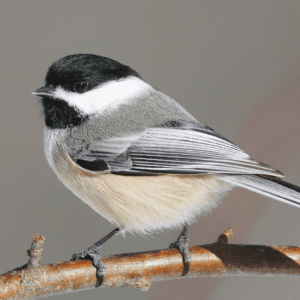 Black-capped chickadees, petite resident songbirds, constitute one of the two chickadee species in North Carolina. Their close resemblance to the Carolina chickadee makes distinguishing between the two challenging, yet variations in range distribution and song provide some distinctions.
Black-capped chickadees, petite resident songbirds, constitute one of the two chickadee species in North Carolina. Their close resemblance to the Carolina chickadee makes distinguishing between the two challenging, yet variations in range distribution and song provide some distinctions.
In contrast to Carolina chickadees, known for their elaborate series of notes with diverse pitches, Black-capped chickadees typically sing a concise song consisting of two to three notes, featuring a higher note at the outset.
While Carolina chickadees thrive in the southern regions, Black-capped chickadees predominantly inhabit northern areas, favoring colder climates and higher elevations, particularly in the upper continental United States, Canada, and Alaska. Their population boundary spans from New Jersey to Kansas, with a branch extending down the Appalachian Mountains into Virginia and the mountains of western North Carolina. At this boundary, hybridization with Carolina chickadees is observed.
During spring and summer, Black-capped chickadees primarily feed on caterpillars, transitioning to seeds and berries in winter. Notably, they are known to cache seeds, storing them in specific locations and revisiting them up to 28 days later.
As cavity nesters, Black-capped chickadees either excavate their own tree cavities or repurpose old woodpecker cavities. Nesting and mating occur between April and June, with the female exclusively involved in nest construction, laying a single clutch of six to eight eggs.
Urban development, deforestation, and the loss of dead trees crucial for nesting cavities pose threats to Black-capped chickadees as cavity nesters. Additionally, their preference for northern climates exposes them to risks associated with climate change, pushing their range northward and potentially excluding them from North Carolina altogether as temperatures rise.
Northern bobwhite (Colinus virginianus):
NC Range: All Regions, but primarily Eastern and Piedmont
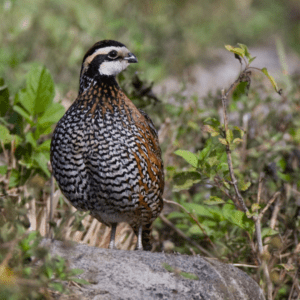 The northern bobwhite, also recognized as the Virginia quail or bobwhite quail, is native to Canada, extending as far south as Mexico and Cuba. Belonging to the quail family, it is a medium-sized bird identified by its distinctive “bobwhite” whistle.
The northern bobwhite, also recognized as the Virginia quail or bobwhite quail, is native to Canada, extending as far south as Mexico and Cuba. Belonging to the quail family, it is a medium-sized bird identified by its distinctive “bobwhite” whistle.
As a ground-dwelling species, the northern bobwhite exhibits a preference for agricultural fields, grasslands, and woodlands. With its highly camouflaged and reserved nature, this elusive bird tends to freeze when feeling threatened, seamlessly blending into its environment. While generally solitary, it may form groups, known as coveys, with up to twenty individuals by the end of summer.
In contrast to species favoring mature forests, northern bobwhites thrive in early successional habitats. Historically, before European settlement, they were prevalent in areas managed by Native Americans through controlled burns. Post-European settlement, agricultural landscapes became their primary habitat.
Feeding on grassland and ground-dwelling insects such as ticks, grasshoppers, crickets, and spiders, northern bobwhites also consume seeds, grains, berries, and partridge peas.
Due to their ground-dwelling nature, northern bobwhites face numerous predators, including skunks, raccoons, hogs, mice, armadillos, opossums, foxes, coyotes, bobcats, birds of prey, feral cats and dogs, and fire ants. Nest failure, often a result of predation, is common, with hens nesting multiple times before successfully producing a clutch.
Habitat loss, arising from the development of natural landscapes and agricultural lands, along with habitat fragmentation, invasion by exotic plant and insect species (particularly fire ants), and the absence of prescribed burning, pose significant threats to the northern bobwhite. Controlled burning is crucial for maintaining the early successional woodlands and grasslands essential for their survival.
Piping Plovers (Charadrius melodus):
NC Range: Coastal
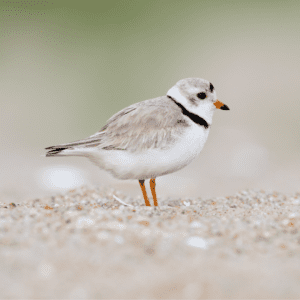 The piping plover, a diminutive shorebird indigenous to North American coasts, currently maintains a few populations along the Atlantic coast, extending to Canada, the shores surrounding the Great Lakes, and the Northern Great Plains in the upper Midwest United States. Preferring sandy and gravel beaches, it possesses effective camouflage, making it inconspicuous while stationary.
The piping plover, a diminutive shorebird indigenous to North American coasts, currently maintains a few populations along the Atlantic coast, extending to Canada, the shores surrounding the Great Lakes, and the Northern Great Plains in the upper Midwest United States. Preferring sandy and gravel beaches, it possesses effective camouflage, making it inconspicuous while stationary.
During low tide, piping plovers forage along coastlines for insects, marine worms, and crustaceans.
Breeding activities typically commence in late March, marked by male plovers engaging in courtship flights and displays to attract potential mates. After forming pairs, males create scrape sites on sandy beaches, which the female evaluates before selecting one. Once chosen, the female camouflages the scrape with shells and shoreline material, allowing the male to mate.
Clutching four eggs, piping plovers hatch their offspring around mid-April. While incubating the eggs, parents employ a “broken wing display” to distract and lead potential predators away from the nest.
As small shorebirds, plovers encounter various predators, especially during their vulnerable young stages or while nesting. Raccoons, crows, feral cats and dogs, foxes, and others pose threats. Additionally, their shoreline nests remain in constant peril from high tides and coastal storms.
In the 19th and 20th centuries, piping plovers were targeted for their feathers, sought after for hat plumes. This exploitation contributed to their initial decline, addressed by the Migratory Bird Treaty Act of 1918. Nevertheless, their population continued dwindling due to habitat loss, degradation, and the impact of shoreline recreational activities.
Numerous state and federal agencies collaborate to protect piping plover nesting habitats. Despite these efforts, the species confronts a myriad of threats to its survival, encompassing increasing habitat loss, human disturbances, domestic animals, and the adverse effects of climate change, particularly rising sand temperatures and sea levels, which unfortunately undermine progress to protect and restore this species.
Ruffed grouse (Bonasa umbellus)
NC Range: Western
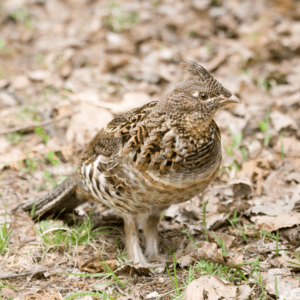 Ruffed grouse stand out as the most widely distributed gamebird, spanning from the mountains of western North Carolina through Canada and Alaska. Remaining non-migratory, they possess effective camouflage tailored to woodland forest floors, especially those abundant in aspen.
Ruffed grouse stand out as the most widely distributed gamebird, spanning from the mountains of western North Carolina through Canada and Alaska. Remaining non-migratory, they possess effective camouflage tailored to woodland forest floors, especially those abundant in aspen.
These omnivorous foragers have a diverse diet, comprising insects, berries, seeds, plant buds, and even small amphibians.
Similar to quail, grouse adeptly conceal themselves on the forest floor, remaining inconspicuous until approached. When disturbed, they erupt into flight with dramatic and noisy wingbeats.
Choosing the forest floor for nesting, ruffed grouse typically opt for logs and stumps as nest sites. Egg-laying occurs around May, resulting in clutches of approximately 9-14 eggs.
As partially ground-dwelling birds, ruffed grouse share common predators with Northern bobwhites, including birds of prey, coyotes, foxes, feral cats and dogs, snakes, and fire ants.
The primary threat to ruffed grouse is habitat loss, encompassing forest clearing for agriculture, tree plantations, and urban development. Despite some parallels with quail, ruffed grouse differ in their requirement for mature deciduous forest habitat. Consequently, clear-cutting for development poses a significant danger to the species. In addition to habitat loss, ruffed grouse also face challenges from West Nile Virus, which emerged in the United States in 1999.
Show your love for red-cockaded woodpeckers and the longleaf pine habitat they need for survival by making a donation to NCWF. Your donation will go towards planting longleaf pines in North Carolina, advocating for continued protections of red-cockaded woodpeckers under the Endangered Species Act, and educating people about red-cockaded woodpeckers and their longleaf pine habitat.
Written by:

– Bates Whitaker, NCWF Communications & Marketing Manager

